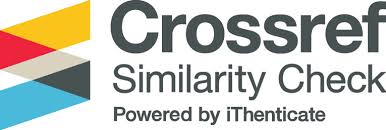Formulation, quality and Organoleptic Test of Solid Soap with Guava Leaf (Psidium guajava L.) as Additive
Abstract
Guava leaves have flavonoids, tannins, and alkaloids as main compounds which have been shown to be active as antibacterial and anticarcinogenic agents. However, they have never been used as additives in skin care products because they have a rough texture. The purpose of this research are to formulate the method in the production of bath soap with the leaves as additives, and they were examined in quality and organoleptic tests. Formulation in production of the soap was carried out by means of variations of the method of extracting guava leaves as additives, namely: without additive as a control (A), with water solvent (B), with vegetable oil solvent (C), and powder dried as a scrub (D). The soap quality tests based on SNI 2016 including tests for alkaline or free fatty acid levels, insoluble ingredients in ethanol and unsaponified fat fractions. Organoleptic test was carried out involving 20 panelists. Data were analyzed by ANOVA-Duncan test. It was found that soap quality test for all samples meet INS except free alkali levels in D soap. The hedonic test results show that all soap samples can be accepted by panelists. Based on quality and organoleptic tests, the formulation method for adding guava leaf extract as an additive that produces the best soap is extraction using a water solvent (soap B). For the next study, it is necessary to confirm the biological activity of soap with guava leaf additives because it is very potential to be used as an antimicrobial soap.
References
[2] BSN, “Sabun mandi padat, SNI 3532:2016.” 2016.
[3] Bruice P Y, Organic Chemistry, Fifth edit. USA: Pearson Prentice Hall, 2007.
[4] Rafiqa Liyana Binti Rahimi, “To Study Optimum Parameter In The Soap Production Derived From Palm Kernel Oil and Palm Oil by Saponification,” Faculty of Chemical and Natural Resources Engineering, Universiti Malaysia Pahang, 2013.
[5] C. O. Onyegbado, E. T. Iyagba, and O. J. Offor, “Solid Soap Production using Plantain Peel Ash as Source of Alkali,” J. Appl. Sci. Environ. Mgt, vol. 6, no. 1, pp. 73–77, 2002.
[6] R. Awang and S. Ahmad, “Properties of Sodium Soap Derived from Palm-Based Dihtdroxystearic Acid,” J. Oil Palm Res., vol. 13, no. 2, pp. 33–38, 2001.
[7] V. Semilin, “Production of Soap From Sesamum Indicum (Sesame Seed),” Universiti Malaysia Pahang, 2014.
[8] S. Asmira, “Semi-Automated Machine to make Soap from Used,” Universiti Teknikal Malaysia Melaka, 2015.
[9] L. Casalla, “Karakteristik sabun tallow dengan penambahan madu sebagai antioksidan laura casalla,” J. Produksi dan Teknol. Peternak., 2014.
[10] R. Muthmainah, D. Rubiyanto, and T. S. Yulianto, “Formulasi Sabun Cair Berbahan Aktif Minyak Kemangi sebagai Antibakteri dan Pengujian terhadap Staphylococcuc Aureus,” Indo.J.Chem.Res, vol. 1, no. 1, pp. 44–50, 2014.
[11] S. Handayani, S. Kristianingrum, and A. Rakhmawati, “Standard Quality and Antibacterial Activity Tests of Clove Oil in Solid Soap Production Against Staphylococcus aureus , Staphylococcus epidermidis and Escherichia coli,” Orient. J. Chem., vol. 34, no. 5, pp. 2410–2417, 2018.
[12] S. M. Barbalho, “Psidium Guajava (Guava): A Plant of Multipurpose Medicinal Applications,” Med. Aromat. Plants, vol. 01, no. 04, 2012, doi: 10.4172/2167-0412.1000104.
[13] N. Thakur and V. Arya, “Preliminary phytochemical analysis of the extracts of psidium leaves,” Middle - East J. Sci. Res., vol. 19, no. 11, pp. 1421–1424, 2014, doi: 10.5829/idosi.mejsr.2014.19.11.11415.
[14] J. V. Kamath, N. Rahul, C. K. A. Kumar, and S. Mohana Laksmi, “Psidium guajava L A review,” Int. J. Green Pharm., vol. 2, no. March 2008, pp. 9–12, 2014.
[15] R. E. Daud Fajar Mohammad, Sadiyah R. Esti, “Pengaruh Perbedaan Metode Ekstraksi terhadap Aktivitas Antioksidan Ekstrak Etanol Daun Jambu Biji ( Psidium Guajava L .) Berdaging Buah Putih,” Pros. SNaPP2011 Sains, Teknol. dan Kesehat., vol. 2, no. 2089–3582, pp. 55–62, 2011.
[16] L. Yulisma, “Staphylococcus aureus dan bacilus subtilis secara in vitro 1,” Issn 1907 – 3089 E-Issn 2651-5869, vol. 10, no. 2, pp. 1–6, 2018.
[17] A. Widyasanti, A. Y. Rahayu, and S. Zein, “Pembuatan Sabun Cair Berbasis Virgin Coconut Oil (VCO) dengan Penambahan Minyak Melati (Jasminum Sambac) sebagai Essential Oil,” J. Teknotan, vol. 11, no. 2, p. 1, 2017, doi: 10.24198/jt.vol11n2.1.
[18] S. W. Trew and Z. B. Gould, Making Natural Soaps. New York: Alpha Books, 2010.
[19] T. K. B. A. S. dan G. A. K. Erliza Hambali, “Aplikasi Dietanolamida Dari Asam Laurat Minyak Inti Sawit Pada Pembuatan Sabun Transparan,” J. Agroindustrial Technol., vol. 15, no. 2, pp. 46–53, 2012.
[20] W. C. Lee, R. Mahmud, R. Noordin, S. P. Piaru, S. Perumal, and S. Ismail, “Alkaloids content, cytotoxicity and anti-Toxoplasma gondii activity of Psidium guajava L. and Tinospora crispa,” Bangladesh J. Pharmacol., vol. 7, no. 4, 2012, doi: 10.3329/bjp.v7i4.12499.













